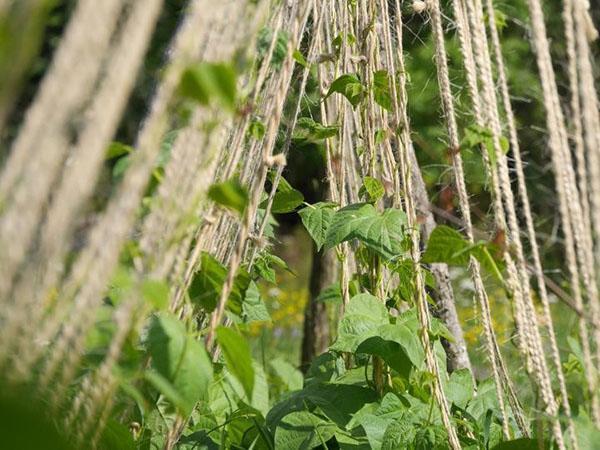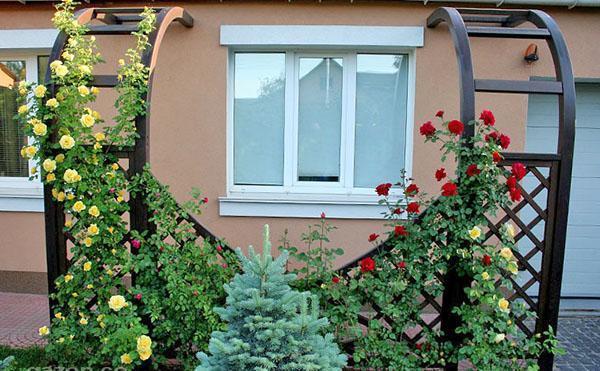How to create a vertical garden
 Vertical gardening, also called intensive gardening, is far from new. However, recently this trend has been actively developing with the expansion of the list of ideas on how exactly such a garden should be grown. This option is especially relevant for gardeners with limited space, where you need to plant more than a few small beds.
Vertical gardening, also called intensive gardening, is far from new. However, recently this trend has been actively developing with the expansion of the list of ideas on how exactly such a garden should be grown. This option is especially relevant for gardeners with limited space, where you need to plant more than a few small beds.
Highlights

- Choosing the right crops is critical. Climbing and climbing plants are already prepared to grow from the ground upwards, unlike shrub varieties, for example.
- Container use will also become critical as the plants mature. Their growth will stall if the pots are too small.
- It is important not to plant plants where they will shade other crops. The best strategy is to separate the sun-loving views from the shade-loving ones.
- The soil under the vertical plants dries out faster, so you need to water it more often.
By following these tips, you will get the most out of vertical gardens.
Benefits of vertical gardening
 The main advantage is the increased yield. Maximum utilization of space means more intensive crop growth. Caring for plants and picking fruits also becomes much easier physically - the plants grow to great heights, thereby eliminating the need to bend or kneel.
The main advantage is the increased yield. Maximum utilization of space means more intensive crop growth. Caring for plants and picking fruits also becomes much easier physically - the plants grow to great heights, thereby eliminating the need to bend or kneel.
In addition, since foliage and fruits are lifted off the ground, they are less susceptible to disease. Vertical planting improves air circulation, therefore, after watering, the plants dry out faster, reducing the risk of picking up moisture-loving viruses such as powdery mildew and rust.
Disease symptoms and signs of pests will be more visible, therefore, protective measures can be taken earlier. In addition, a larger area of foliage is exposed to the sun, resulting in healthier growth.
 When choosing varieties for a vertical garden, take into account the peculiarities of caring for them and their features, because the success of the whole business will depend on this.
When choosing varieties for a vertical garden, take into account the peculiarities of caring for them and their features, because the success of the whole business will depend on this.
Recommended plants for vertical planting
Here are a few crops that can easily master the ability to grow vertically:
- cherry tomatoes, for example, "Sangold", "Black cherry", "Blondkopfchen";
- cucumbers "Saladin F1", "Dasher 11";
- green beans;
- lima beans;
- melon ("Tiger", "Sleeping Beauty", "White Miracle", "Yellow Doll");
- peas ("sweet", "double", "super sweet");
- zucchini ("zucchini", "yellow summer").
Frame for vertical garden
 When choosing support structures, consider the effects of the sun and wind, the size of the frame and the characteristics of the plants themselves. That is, leafy plants with tendrils, such as beans, do well on light supports such as trellises and tripods, while more massive crops (such as vines) require stronger frames. In this case, an arch or a gazebo will do. Keep in mind that the structure must be able to support the weight of an adult plant and be well anchored to prevent tipping over.
When choosing support structures, consider the effects of the sun and wind, the size of the frame and the characteristics of the plants themselves. That is, leafy plants with tendrils, such as beans, do well on light supports such as trellises and tripods, while more massive crops (such as vines) require stronger frames. In this case, an arch or a gazebo will do. Keep in mind that the structure must be able to support the weight of an adult plant and be well anchored to prevent tipping over.
 There are many types of supports to choose from. In addition to trellises, arches, tripods and pergolas, there are gazebos, wire cages, nets, and pillars.
There are many types of supports to choose from. In addition to trellises, arches, tripods and pergolas, there are gazebos, wire cages, nets, and pillars.
Look for materials that can be reused. For example, wooden pallets, which are often thrown away by shops.
Now you have an idea of what vertical gardening is. Try this method and let the sky be the limit for your plants!